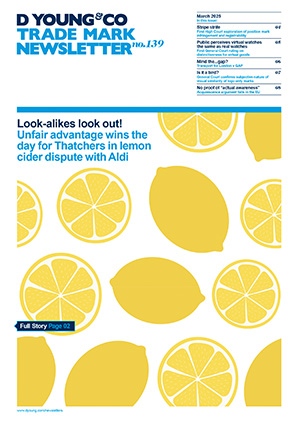What does the EUIPO want? Clarity and precision for colour combination marks
The recent decision of the Second Board of Appeal of the EUIPO in case R 2087/2023-2 illustrates the importance of (optional) descriptions in relation to colour combination marks.
This article first appeared in WTR Daily, part of World Trademark Review, in April 2024. For further information, please go to www.worldtrademarkreview.com.
Background
In 2020 Storch-Ciret Holding GmbH applied for the following colour mark in classes 6, 8, 9, 16, 17, 20 and 35:

The application indicated five colour codes and included the description: “Claiming the colours in the colour sequence as shown, with or without spacing”.
Four years later, the Board of Appeal confirmed the examiner’s refusal based on Article 7(1)(a) of Regulation 2017/1001, but the case was not as straightforward as one might think.
The EUIPO had first noted that the mark should have been categorised as a figurative mark. Storch-Ciret had, in fact, intended for the above application to be a colour mark and informed the EUIPO accordingly.
Following this, the EUIPO considered that the application lacked reference to a generally recognised colour code, and that the representation and description did not match. In response, Storch-Ciret added a sixth colour code and even requested for the description to be deleted in its entirety (for clarification purposes, the EUIPO considered “white” to be the sixth colour).
The EUIPO nevertheless refused the application based on non-distinctiveness. The Second Board of Appeal overturned this decision. The reasoning provided related to a figurative mark, and not a colour mark. The case was referred back to the examiner for further examination of the requirements under Article 4 of the regulation, in particular, the clarity and precision of the application.
In 2023 the EUIPO issued a refusal on that basis. In addition, the EUIPO appeared to have given a little nod to the Board of Appeal by stating that, while the refusal based on Article 7(1)(b) was no longer maintained, its concerns remained. Storch-Ciret appealed.
Storch-Ciret’s main arguments were that a description is no longer needed for colour combination marks and that the scope of protection would be sufficiently clear and precise by looking at the representation itself. Further, due to the disproportionate length of the proceedings, the entire process felt arbitrary.
Decision
The Second Board of Appeal (with the same combination as before except from one member) confirmed the refusal and rejected the appeal, albeit noting that the EUIPO’s decision showed weaknesses in its reasoning, and giving a decision on the matter in view of the duration of the proceedings.
The Board of Appeal noted that Article 3(3)(f)(ii) implemented the case law of the Court of Justice of the European Union (CJEU) requiring a systematic arrangement of the colour combination in a uniform and predetermined manner. The mere combination of two or more colours without shape or contour would result in too many possible different variations and not be sufficiently clear and precise.
With regard to the application, the five squares were reminiscent of mere colour samples. Storch-Ciret argued only that the application claimed what could be clearly seen. However, inferring from the application that the combination of colours was claimed only for the sequence as shown would be inconsistent with claiming a colour mark. The application would lack a systematic arrangement as to its quantitative distribution. Consequently, the potential colour combinations would simply be too many.
Comment
Aside from the potential frustration shown by both the EUIPO and Board of Appeal, this decision is not overly surprising. Without a description, it is completely unclear how the colours would be applied to an actual product. This shows that, while a description is not mandatory in relation to colour combination marks, a proper description may be required. However, looking at the EUIPO register, Storch-Ciret seems to be in good company.
Case details at a glance
Jurisdiction: European Union
Decision level: EUIPO Second Board of Appeal
Applicant: Storch-Ciret Holding GmbH
Citation: Case R 2087/2023-2
Date: 07 February 2024
Useful link
Regulation 2017/1001, Official Journal of the European Union, L 154/1, 16 May 2017 (PDF): dycip.com/2017-1001-eu-journal-may2017

